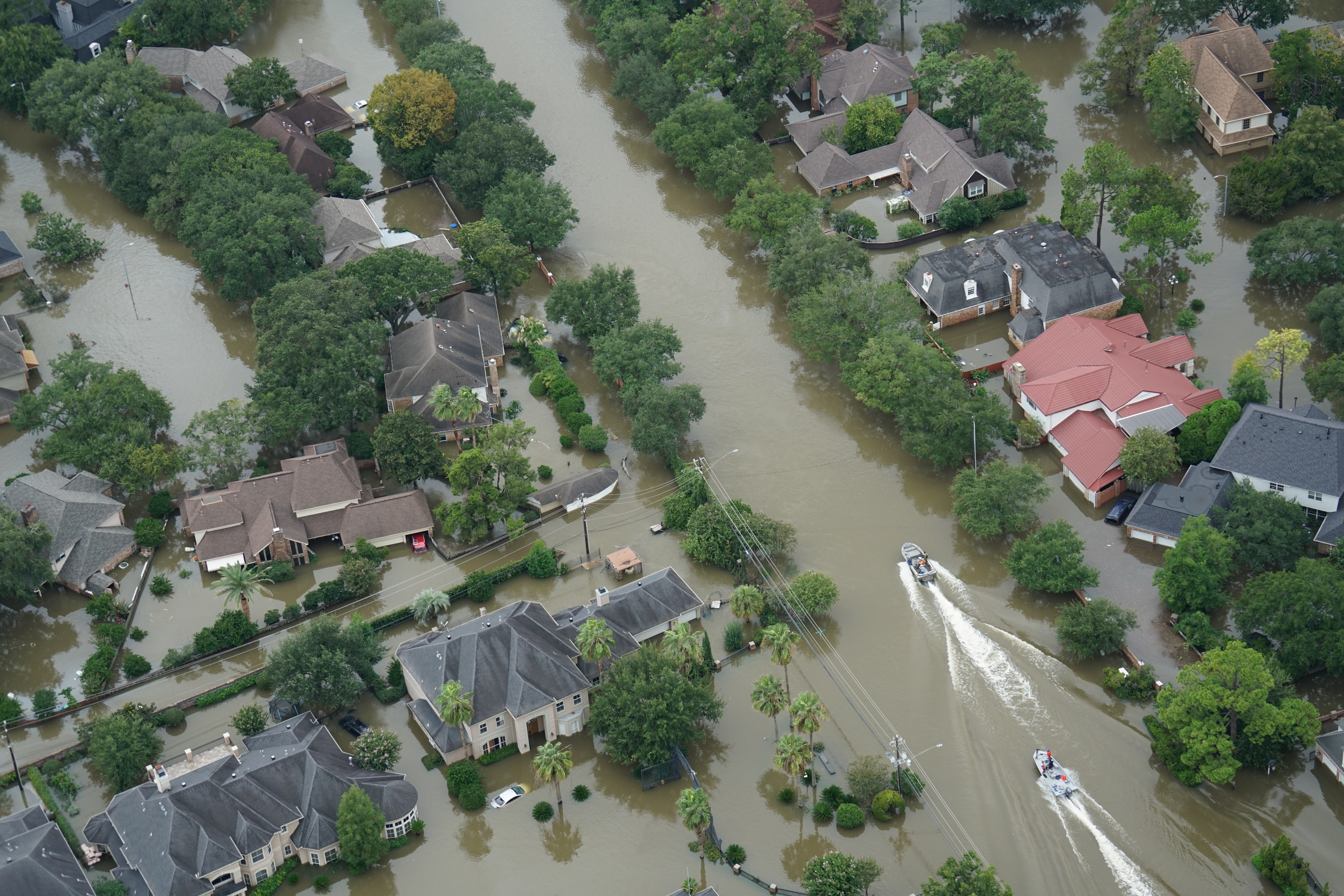A Broke, and Broken, Flood Insurance Program

November 3, 2017
New York Times — 11.04.2017
By Mary Williams Walsh
In August, when Hurricane Harvey was bearing down on Texas, David Clutter was in court, trying one more time to make his insurer pay his flood claim — from Hurricane Sandy, five years before.
Mr. Clutter’s insurer is the federal government. As it resists his claims, he has been forced to take out a third mortgage on his house in Long Beach, N.Y., to pay for repairs to make it habitable for his wife and three children. He owes more than the house is worth, and his flood-insurance premiums just went up.
The government-run National Flood Insurance Program is, for now, virtually the only source of flood insurance for more than five million households in the United States. This hurricane season, as tens of thousands of Americans seek compensation for storm-inflicted water damage, they face a problem: The flood insurance program is broke and broken.
The program, administered by the Federal Emergency Management Agency, has been in the red since Hurricane Katrina flooded New Orleans in 2005. It still has more than a thousand disputed claims left over from Sandy. And in October, it exhausted its $30 billion borrowing capacity and had to get a bailout just to keep paying current claims.
Congress must decide by Dec. 8 whether to keep the program going. An unusual coalition of insurers, environmentalists and fiscal conservatives has joined the Trump administration in calling for fundamental changes in the program, including direct competition from private insurers. The fiscal conservatives note that the program was supposed to take the burden off taxpayers but has not, and environmentalists argue that it has become an enabler of construction on flood-prone coastlines, by charging premiums too low to reflect the true cost of building there.
The program has other troubles as well. It cannot force vulnerable households to buy insurance, even though they are required by law to have it. Its flood maps can’t keep up with new construction that can change an area’s flood risk. It has spent billions of dollars repairing houses that just flood again. Its records, for instance, show that a house in Spring, Tex., has been repaired 19 times, for a total of $912,732 — even though it is worth only $42,024.
And after really big floods, the program must rely on armies of subcontractors to determine payments, baffling and infuriating policyholders, like Mr. Clutter, who cannot figure out who is opposing their claims, or why.
Roy E. Wright, who has directed the flood insurance program for FEMA since June 2015, acknowledged in an interview on Friday that major changes were called for and said some were already in the works. The program’s rate-setting methods, for example, are 30 years old, he said, and new ones will be phased in over the next two years. But other changes — like cutting off coverage to homes that are repeatedly flooded — would require an act of Congress.
“The administration feels very strongly that there needs to be reform this year,” he said. “I believe strongly that we need to expand flood coverage in the United States, and the private insurers are part of that.”
The federal program was created to fill a void left after the Great Mississippi Flood of 1927, when multiple levees failed, swamping an area bigger than West Virginia and leaving hundreds of thousands homeless. Insurers, terrified of the never-ending claims they might have to pay, started to exclude flooding from homeowners’ insurance policies. For decades, your only hope if your home was damaged in a flood was disaster relief from the government.
Policymakers thought an insurance program would be better than ad hoc bailouts. If crafted properly, it would make developers and homeowners pay for the risks they took.
When Congress established the National Flood Insurance Program in 1968, it hoped to revive the private flood-insurance market. Initially about 130 insurers gave it a shot, pooling their capital with the government. But there were clashes, and eventually the government drove out the insurers and took over most operations.
Since 1983, Washington has set the insurance rates, mapped the floodplains, written the rules and borne all of the risk. The role of private insurers has been confined to marketing policies and processing claims, as government contractors.
That worked for a few decades. But now, relentless coastal development and the increasing frequency of megastorms and billion-dollar floods have changed the calculus.
“Put plainly, the N.F.I.P. is not designed to handle catastrophic losses like those caused by Harvey, Irma and Maria,” Mick Mulvaney, the director of the White House Office of Management and Budget, said in a letter to members of Congress after the three huge hurricanes barreled into the United States this season.
Mr. Mulvaney called on Congress to forgive $16 billion of the program’s debt, which both houses agreed to do.
The program, however, needs more than a financial lifeline: Without major, long-term changes, it will just burn through the $16 billion in savings and be back for more.
The White House is hoping to lure companies back into the market, letting them try to turn a profit on underwriting flood policies instead of simply processing claims for the government.
One measure proposed by the Trump administration is for the government to stop writing coverage on newly built houses on floodplains, starting in 2021. New construction there is supposed to be flood-resistant, and if the government retreats, private insurers may step in. Or so the theory goes.
The private market is anxious, willing and completely able to take everything except the severe repetitive-loss properties,” said Craig Poulton, chief executive of Poulton Associates, which underwrites American risks for Lloyd’s of London, the big international insurance marketplace.
“Severe repetitive-loss properties” is FEMA’s term for houses that are flooded again and again. There are tens of thousands of them. While they account for fewer than 1 percent of the government’s policies, they make up more than 10 percent of the insurance claims, according to the Natural Resources Defense Council, which sued FEMA to get the data.
The Trump administration has also proposed creating a new category of properties that are at extreme risk of repeat flooding and that could have their insurance cut off the next time they flooded.
That might sound harsh. Environmental groups, though, argue it’s worse to repeatedly repair doomed houses on flood-prone sites as oceans warm and sea levels rise. The Natural Resources Defense Council argues that the flood-insurance program should buy such properties so the owners can move somewhere safer.
The program, however, has only limited authority to make such purchases; homeowners need to line up funding through other government agencies. As a result, such buyouts are rare.
“I have mounds and mounds of paper, and I’m still waiting,” said Olga McKissic of Louisville, Ky., who applied for a buyout in 2015 after her house flooded for the fifth time. “I want them to tear it down.”
Ms. McKissic even had her house classified as a severe repetitive-loss property, thinking FEMA would give it higher priority. But FEMA has not responded to her application. Instead, it doubled her premiums.
That’s what happens when there’s a monopoly, said Mr. Poulton, the Lloyd’s underwriter.
Over the years, he said, he has noticed that his customers are buying Lloyd’s earthquake insurance because it includes flood coverage. They do not like the government’s flood insurance because payouts are capped at $250,000 and have other limits.
Such as basements.
Matt Herr of Superior Flood in Brighton, Colo., another underwriter for Lloyd’s, recalled a client whose handicapped son lived in a “sunken living room,” eight inches lower than the rest of the house. When the neighborhood flooded, $22,000 of medical equipment was ruined. The government refused to pay, calling the living room a basement. Its policies exclude basements.
While the government program insures more than five million homeowners, that is just a small fraction of the number of people who live on floodplains.
Mr. Poulton researched the flood insurance program and eventually found a public report that explained how its pricing worked. The program, he learned, was not using the detailed, house-by-house information on flood risk that is available through satellite imagery and other sources.
That’s because Congress gave the program a legal mandate to work with communities, not individual households. So the program was surveying floodplains, then calculating an “average annual loss” for all the houses there. Its insurance rates were based on those averages.
“It undercharges 50 percent of its risks, and it overcharges 50 percent of its risks, on an equal weighting,” Mr. Poulton said.
Offer a better deal to the households with a below-average risk of flooding — a policy whose price reflects their lower risk — and they will jump at the opportunity to save money on premiums, he said.
But the government does not readily divulge all of its historical claims data, so insurers cannot comb through them and analyze the risks.
“What we know is snippets,” said Martin Hartley, chief operating officer of Pure Insurance in White Plains, which offers supplementary flood insurance to homeowners who want more than the government’s $250,000 coverage.
Also, the government relies on mortgage lenders to enforce the rule requiring at-risk homeowners to buy flood insurance. Mr. Poulton said he found that FEMA officials had told lenders that, in effect, they shouldn’t trust private insurance.
He went to Washington to complain to program officials.
“We told them their guidelines were bad, bad for consumers,” he said. “We said: ‘They’re only good for you. You’ve got to change them.’ They said: ‘We don’t answer to you. We answer to Congress.’ We’ve been lobbying ever since.”
No one paid much attention until after Sandy, when the program fell deeper into debt with the Treasury. To help fill that hole, Congress in 2012 approved big increases in its premiums. But that caused an uproar when people got their bills. Two years later, Congress rescinded much of the increase.
Then came this season’s hurricanes and the $16 billion bailout.
The Office of Management and Budget sent Congress an updated list of proposals in October, including measures that would remove certain obstacles to private-sector competition. Its plan would open up the data trove to potential competitors and direct mortgage lenders to accept private flood-insurance policies. It would also revoke an agreement that the program’s contractors — including about 70 insurance companies — must currently sign, promising not to compete against the government program.
Some members of Congress — including Democrats like Senators Chuck Schumer of New York and Robert Menendez of New Jersey, whose states have significant flood exposure and bad memories of Hurricane Sandy — are resisting. They say bringing in private insurers would make the program’s troubles worse, because the insurers would cherry-pick the most profitable customers and leave the government with all the “severe repetitive-loss properties.”
Mr. Poulton did not dispute that. In fact, he said that was exactly what should happen
“We need the N.F.I.P. to be a full participant in this as the insurer of last resort,” he said. That means it would take the high-risk properties that the private insurers did not want, acting like the state-run insurance pools for especially risky drivers.
Some lawyers for aggrieved policyholders think a shake-up might improve things, if it brought accountability.
August J. Matteis, who is representing Mr. Clutter in his lawsuit, said the insurance program had been so criticized by Congress for its borrowing that by the time Sandy blew in, it had instructed contractors to hold the line on claims. They did so with a vengeance. Thousands of people with flood damage from Sandy ended up disputing the government’s handling of their claims — so many that New York State’s attorney general, Eric T. Schneiderman, conducted an investigation that found unlicensed engineers, hidden fees, forged reports “and other evidence of crimes which fall outside the scope of New York State’s jurisdiction.”
Long Beach, Mr. Clutter’s town, is on a barrier island off the southern shore of Long Island. When Sandy sent several feet of floodwater washing over it, the piers supporting the Clutter family’s foundation collapsed. Upstairs, floors buckled. Walls cracked.
Mr. Clutter called Wright National Flood Insurance, the Florida company that administers his policy. Wright sent an independent adjuster, who took photos with captions like “structural foundation wall has been washed in” and “piers have collapsed — no longer supporting risk.”
But then, Wright sent a structural engineer from U.S. Forensic of Louisiana who declared that Sandy had not caused the damage.
In 2015, Mr. Clutter happened to catch a “60 Minutes” report on the aftermath of Sandy. It included accusations that U.S. Forensic had falsified engineering reports on other people’s houses.
There were so many disputed claims and questionable inspections, in fact, that the government opened an unusual review process for Sandy victims. Mr. Clutter went through it, but said the government’s offer fell far short of his repair costs. He sued FEMA and Wright Flood Insurance in August.
Michael Sloane, Wright Flood’s executive vice president, said in an email that while the company could not comment on Mr. Clutter’s case, “we are always committed to working with our customers to keep the lines of communication open as we continue working toward resolution.”
U.S. Forensic did not respond to messages.
Mr. Wright, the program director, acknowledged the problems after Sandy but said corrective measures had been taken “so that it doesn’t happen again.”
Much of Long Beach has been rebuilt since Sandy. Small houses like Mr. Clutter’s are being torn down and replaced with bigger ones that sprawl across two lots. Mr. Clutter worries that if insurers, not the government, set the prices, premiums will soar.
“Then, what happens to me?” he asked. “I’m essentially being driven out of my home that I have three mortgages on.”





